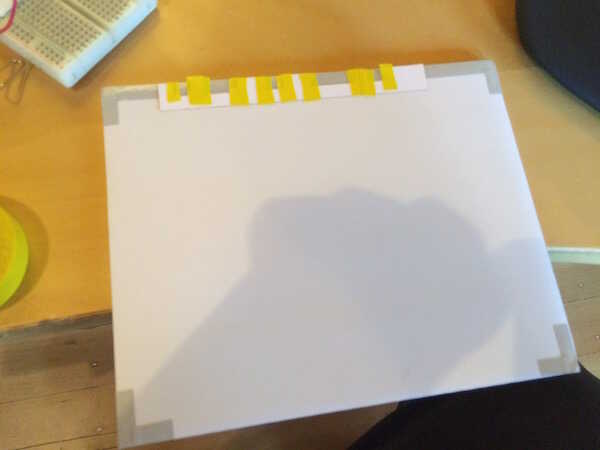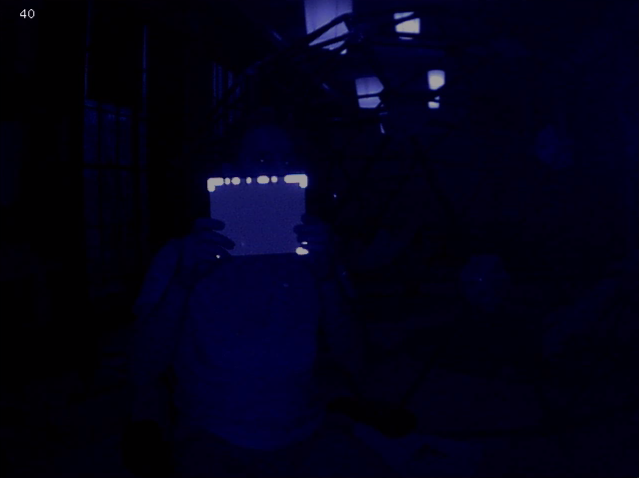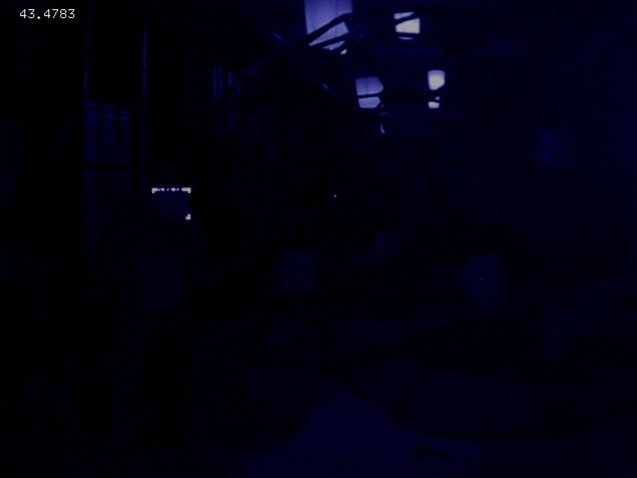Tried narrowing the slots with some electrical tape to reduce the bloom. Maybe it's a bit better?
The last photo is roughly the distance that we'd like to be able to identify at (about 6.5% of the frame width), although ideally with a 3x higher-resolution camera. (With the current resolution, the last photo has only about 1 bit per pixel -- it's amazing it's as recognizable as it is.)
I feel like some variation on "embed an encoding into the retroreflective pattern" could eventually work well enough, especially because we don't have to identify on every frame -- we have to track on every frame, but identify only initially and occasionally. (Maybe the system could say "I see an object but I can't identify it; could you please move it closer to the camera for a bit?")




On Mar 3, 2016, at 6:26 PM, Toby Schachman wrote:I did a quick screen test of this (video attached).One thing that's tricky is the retroreflective stuff gives off a "glow". This could probably be modulated down by using less bright LEDs (I'm using my newest super-bright rig which was made for tracking dots).Also I've dialed down the exposure and gamma to their minimum (like we do for laser tracking).<image.png><image.png><image.png>Here is the test barcode. Mask made in Apparatus and laser cut from index card thick paper. Resolution of the code is 1/4" per bit.<image.png><barcode screen test.mp4>On Thu, Mar 3, 2016 at 9:09 AM, Bret Victor wrote:At 7 am this morning my neighbors started throwing tree parts into a metal dumpster, which woke me up from a dream that Ted Nelson had changed his name so people would stop asking him for reprints of the Whole Earth Catalog but also about using retroreflective bar codes to identify objects.Consider a foamcore piece on big board. Put retroreflective tape on the corners, and also a strip along the top edge. Then print out a mask (either white ink on transparent plastic, or laser-cut white paper with holes) with a barcode pattern, and overlay it on the top edge. If the mask is the same-ish color as the retroreflective tape, it shouldn't be too noticeable.****************."><a.jpg>To the IR camera, it should look like****************."><b.jpg>How many unique IDs could we represent with this barcode? Back of the envelope:Big board's camera coverage would be about 16 DPI with a 1080p camera.****************."><c.jpg>The smallest piece of foamcore is about 8" wide, or 128 camera pixels.****************."><d.jpg>If we make our bars 4 px wide, that fits 32 bars.****************."><e.jpg>If, for verification, we say that the top strip will have two identical copies of the code side-by-side, that gives us 16-bit codes.****************."><f.jpg>If we discard codes with runs of 4 or more 0s or 1s, that's about 22,900 unique IDs. (The copies and the discarded codes are about trying to avoid misidentification when parts of the code are blocked by a hand or body, which will happen frequently.)22,900 should be "enough for anyone"?